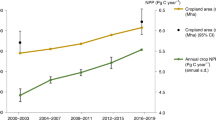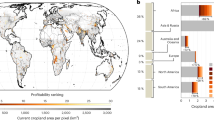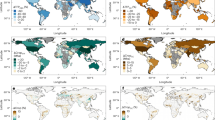Abstract
Achieving the 1.5 °C target outlined in the Paris Agreement necessitates coordinated global efforts, particularly in the form of ambitious climate pledges. While current discussions primarily focus on energy and emissions pathways, the fine-scale, ___location-specific consequences for agriculture, land systems and sustainability remain uncertain. Here we evaluate global land-system responses at 5-km2 resolution in pursuit of the 1.5 °C target through recent country-specific climate pledges. Contrary to previous studies predicting cropland expansion under a 1.5 °C scenario, we reveal a 12.8% reduction in cropland area when accounting for cross-sectoral impacts of climate pledges and land-use intensity. The reduction is most pronounced in South America (23.7%), with the global south comprising 81% of the countries worldwide expected to experience cropland loss. Food security in the Global South faces additional pressure due to a projected 12.6% reduction in export potential from the global north.
This is a preview of subscription content, access via your institution
Access options
Access Nature and 54 other Nature Portfolio journals
Get Nature+, our best-value online-access subscription
27,99 € / 30 days
cancel any time
Subscribe to this journal
Receive 12 print issues and online access
209,00 € per year
only 17,42 € per issue
Buy this article
- Purchase on SpringerLink
- Instant access to full article PDF
Prices may be subject to local taxes which are calculated during checkout




Similar content being viewed by others
Data availability
The detailed trade matrix of the FAO is available at https://www.fao.org/faostat/en/#data/TM. The agricultural inventory data are available at http://www.earthstat.org/harvested-area-yield-175-crops/. The FAO corporate statistical database can be accessed at https://www.fao.org/faostat/en/#definitions. The ___location characteristics are archived at https://www.cell.com/cms/10.1016/j.isci.2023.106364/attachment/d3fdb890-f27c-423d-9e44-ed4a90c6b22c/mmc2.xlsx. The administrative boundaries data come from https://data.humdata.org/dataset/global-edge-matched-subnational-boundaries-humanitarian and https://cloudcenter.tianditu.gov.cn/administrativeDivision. The boundary data for the 235 basins in the GCAM can be downloaded at https://github.com/JGCRI/moirai/blob/master/indata/Global235_CLM_5arcmin.bil.
Code availability
The GCAM is an open-source model available at https://github.com/JGCRI/gcam-core/releases. The version of the GCAM and additional input files associated with this study are available via Zenodo at https://doi.org/10.5281/zenodo.7069066 (ref. 50). The land-change model was adopted from Gao et al.51, and its source code is available at https://github.com/gaoyifan2021/Land-N2N-v1.
Change history
06 May 2025
A Correction to this paper has been published: https://doi.org/10.1038/s41558-025-02353-7
References
The Paris Agreement (United Nations Framework Convention on Climate Change (UNFCCC), 2015).
Grant, N. The Paris Agreement’s ratcheting mechanism needs strengthening 4-fold to keep 1.5°C alive. Joule 6, 703–708 (2022).
Iyer, G. et al. The path to 1.5°C requires ratcheting of climate pledges. Nat. Clim. Change 12, 1092–1093 (2022).
Pianta, S. & Brutschin, E. Increased ambition is needed after Glasgow. Nat. Clim. Change 13, 505–506 (2023).
van de Ven, D.-J. et al. A multimodel analysis of post-Glasgow climate targets and feasibility challenges. Nat. Clim. Change 13, 570–578 (2023).
Aleluia Reis, L. & Tavoni, M. Glasgow to Paris—the impact of the Glasgow commitments for the Paris climate agreement. iScience 26, 105933 (2023).
Roelfsema, M. et al. Taking stock of national climate policies to evaluate implementation of the Paris Agreement. Nat. Commun. 11, 2096 (2020).
Gasser, T., Ciais, P. & Lewis, S. L. How the Glasgow Declaration on Forests can help keep alive the 1.5°C target. Proc. Natl Acad. Sci. USA 119, e2200519119 (2022).
Ou, Y. et al. Can updated climate pledges limit warming well below 2°C? Science 374, 693–695 (2021).
Meinshausen, M. et al. Realization of Paris Agreement pledges may limit warming just below 2°C. Nature 604, 304–309 (2022).
Iyer, G. et al. Ratcheting of climate pledges needed to limit peak global warming. Nat. Clim. Change 12, 1129–1135 (2022).
Millar, R. J. et al. Emission budgets and pathways consistent with limiting warming to 1.5°C. Nat. Geosci. 10, 741–747 (2017).
Luo, M. et al. 1 km land use/land cover change of China under comprehensive socioeconomic and climate scenarios for 2020–2100. Sci. Data 9, 110 (2022).
Chevuturi, A., Klingaman, N. P., Turner, A. G. & Hannah, S. Projected changes in the Asian-Australian monsoon region in 1.5°C and 2.0°C global-warming scenarios. Earth’s Future 6, 339–358 (2018).
Su, B. D. et al. Drought losses in China might double between the 1.5 °C and 2.0 °C warming. Proc. Natl Acad. Sci. USA 115, 10600–10605 (2018).
Warren, R., Price, J., Graham, E., Forstenhaeusler, N. & VanDerWal, J. The projected effect on insects, vertebrates, and plants of limiting global warming to 1.5°C rather than 2°C. Science 360, 791–795 (2018).
Chen, G. Z. et al. Global projections of future urban land expansion under shared socioeconomic pathways. Nat. Commun. 11, 537 (2020).
Colón-González Felipe, J. et al. Limiting global-mean temperature increase to 1.5–2°C could reduce the incidence and spatial spread of dengue fever in Latin America. Proc. Natl Acad. Sci. USA 115, 6243–6248 (2018).
Gao, P. C. et al. Fulfilling global climate pledges can lead to major increase in forest land on Tibetan Plateau. iScience 26, 106364 (2023).
Chen, G. Z., Li, X. & Liu, X. P. Global land projection based on plant functional types with a 1-km resolution under socio-climatic scenarios. Sci. Data 9, 125 (2022).
Popp, A. et al. Land-use futures in the shared socio-economic pathways. Global Environ. Change 42, 331–345 (2017).
Cao, M. et al. Spatial sequential modeling and predication of global land use and land cover changes by integrating a global change assessment model and cellular automata. Earth’s Future 7, 1102–1116 (2019).
Winkler, K., Fuchs, R., Rounsevell, M. & Herold, M. Global land use changes are four times greater than previously estimated. Nat. Commun. 12, 2501 (2021).
Potapov, P. et al. Global maps of cropland extent and change show accelerated cropland expansion in the twenty-first century. Nat. Food 3, 19–28 (2022).
Gao, P. C., Liu, Z., Liu, G., Zhao, H. R. & Xie, X. X. Unified metrics for characterizing the fractal nature of geographic features. Ann. Am. Assoc. Geogr. 107, 1315–1331 (2017).
Jiang, B. & Yin, J. J. Ht-index for quantifying the fractal or scaling structure of geographic features. Ann. Assoc. Am. Geogr. 104, 530–540 (2014).
Janssens, C. et al. Global hunger and climate change adaptation through international trade. Nat. Clim. Change 10, 829–835 (2020).
Liu, H. X. et al. How to balance land demand conflicts to guarantee sustainable land development. iScience 26, 106641 (2023).
Bren d’Amour, C. et al. Future urban land expansion and implications for global croplands. Proc. Natl Acad. Sci. USA 114, 8939–8944 (2017).
Yu, Q. Y., Hu, Q., van Vliet, J., Verburg, P. H. & Wu, W. B. GlobeLand30 shows little cropland area loss but greater fragmentation in China. Int. J. Appl. Earth Obs. Geoinf. 66, 37–45 (2018).
Bousfield, C. G., Morton, O. & Edwards, D. P. Climate change will exacerbate land conflict between agriculture and timber production. Nat. Clim. Change 14, 1071–1077 (2024).
Fuhrman, J. et al. Food–energy–water implications of negative emissions technologies in a +1.5 °C future. Nat. Clim. Change 10, 920–927 (2020).
Wise, M. et al. Implications of limiting CO2 concentrations for land use and energy. Science 324, 1183–1186 (2009).
Self, A., Burdon, R., Lewis, J., Riggs, P. & Dooley, K. Land Gap Report Briefing Note: 2023 Update (The Land Gap Report, 2023).
Fujimori, S., Hasegawa, T., Ito, A., Takahashi, K. & Masui, T. Gridded emissions and land-use data for 2005–2100 under diverse socioeconomic and climate mitigation scenarios. Sci. Data 5, 180210 (2018).
Rogelj, J. et al. Scenarios towards limiting global mean temperature increase below 1.5 °C. Nat. Clim. Change 8, 325–332 (2018).
Wang, T. et al. Atmospheric dynamic constraints on Tibetan Plateau freshwater under Paris climate targets. Nat. Clim. Change 11, 219–225 (2021).
Hu, Q. et al. Global cropland intensification surpassed expansion between 2000 and 2010: a spatio-temporal analysis based on GlobeLand30. Sci. Tot. Environ. 746, 141035 (2020).
Nechifor, V. & Ferrari, E. Trading for climate resilience. Nat. Clim. Change 10, 804–805 (2020).
Fujimori, S. et al. Land-based climate change mitigation measures can affect agricultural markets and food security. Nat. Food 3, 110–121 (2022).
Kornhuber, K. et al. Amplified Rossby waves enhance risk of concurrent heatwaves in major breadbasket regions. Nat. Clim. Change 10, 48–53 (2020).
Vernon, C. et al. Global235_CLM_5arcmin.bil. GitHub https://github.com/JGCRI/moirai/blob/master/indata/Global235_CLM_5arcmin.bil (2017).
Global Edge-Matched Subnational Boundaries: Humanitarian (Humanitarian Data Exchange, 2024); https://data.humdata.org/dataset/global-edge-matched-subnational-boundaries-humanitarian
Administrative Division Visualization (National Geomatics Center of China, 2024); https://cloudcenter.tianditu.gov.cn/administrativeDivision
Calvin, K. et al. GCAM v5.1: representing the linkages between energy, water, land, climate, and economic systems. Geosci. Model Dev. 12, 677–698 (2019).
Wang, Y. H., Song, C. Q., Gao, Y. F., Ye, S. J. & Gao, P. C. Integrating national integrated assessment model and land-use intensity for estimating China’s terrestrial ecosystem carbon storage. Appl. Geog. 162, 103173 (2024).
Tsendbazar, N. E. et al. Developing and applying a multi-purpose land cover validation dataset for Africa. Remote Sens. Environ. 219, 298–309 (2018).
IPCC. Special Report on Global Warming of 1.5 °C (eds Masson-Delmotte, V. et al.) (Cambridge Univ. Press, 2019).
Monfreda, C., Ramankutty, N. & Foley, J. A. Farming the planet: 2. Geographic distribution of crop areas, yields, physiological types, and net primary production in the year 2000. Global Biogeochem. Cycles 22, GB1022 (2008).
Ou, Y. Model and input files for Iyer & Ou, et al. 2022 (Ratcheting of climate pledges needed to limit peak global warming). Zenodo https://doi.org/10.5281/zenodo.7069065 (2022).
Gao, Y., Song, C., Liu, Z., Ye, S. & Gao, P. Land-N2N: an effective and efficient model for simulating the demand-driven changes in multifunctional lands. Environ. Model. Soft. 185, 106318 (2025).
Acknowledgements
This study was supported by the National Natural Science Foundation of China (grant nos. 42230106 and 42271418). H.M. was supported by the National Research Foundation of Korea (grant no. RS-2024-00467678). Y.O. was supported by the National Natural Science Foundation of China (grant no. 72474002). P.G. thanks L. Chen and J. Lv for their help with the experiments. G.I. is also affiliated with Pacific Northwest National Laboratory, which did not provide specific support for this paper. The views and opinions expressed in this paper are those of the authors alone and do not necessarily state or reflect those of the affiliated organizations or the governments of the United States, Korea and China, and no official endorsement should be inferred.
Author information
Authors and Affiliations
Contributions
P.G., H.M. and C.S. designed the research; P.G. led the experiments and wrote the first draft; Y.G. performed the land-change modelling module; Y.O., H.M. and G.I. performed the GCAM module; S.Y. and X.Y analysed part of the results; P.G., Y.O. and H.M. led the revisions.
Corresponding authors
Ethics declarations
Competing interests
The authors declare no competing interests.
Peer review
Peer review information
Nature Climate Change thanks Gerd Angelkorte, Yujun Yi and the other, anonymous, reviewer(s) for their contribution to the peer review of this work.
Additional information
Publisher’s note Springer Nature remains neutral with regard to jurisdictional claims in published maps and institutional affiliations.
Extended data
Extended Data Fig. 1 Global land system map for 2100 and land system type transformations from 2015 to 2100 under the baseline scenario.
a, Global land system map for 2100. It retains the same spatial and thematic resolutions as the base maps. b, A comparison of the global land system map between 2015 and 2100. The blank areas represent regions that have not changed from 2015 to 2100. The colorful areas represent land system types in 2100 that have changed from 2015 to 2100. c, Summary of pixel-by-pixel transformations from 2015 to 2100. Water basin boundaries data from ref. 42.
Extended Data Fig. 2 Global land system map for 2100 and land system type transformations from 2015 to 2100 under the 2 °C scenario.
a, Global land system map for 2100. It retains the same spatial and thematic resolutions as the base maps. b, A comparison of the global land system map between 2015 and 2100. The blank areas represent regions that have not changed from 2015 to 2100. The colorful areas represent land system types in 2100 that have changed from 2015 to 2100. c, Summary of pixel-by-pixel transformations from 2015 to 2100. Water basin boundaries data from ref. 42.
Extended Data Fig. 3 Cropland loss by 2100 under the baseline scenario compared to reference year 2015 at the country scale.
a, Relative cropland loss by 2100. The blank areas represent the countries or regions where no cropland loss, while the colorful areas represent the countries or regions with cropland loss. b-c, Category of land systems in 2100 at hotpots. The colorful areas represent the regions that were cropland in 2015 but are no longer retained in 2100. The blank areas represent the regions that were cropland in 2015 and retain so in 2100, or that were not cropland in 2015. Administrative boundaries data from refs. 43,44.
Extended Data Fig. 4 Primary sources (top 10) of cropland product imports for Korea in 2015.
These sources are USA, Brazil, Chinese mainland, Ukraine, Argentina, Australia, Indonesia, Russia, Malaysia and Romania.
Extended Data Fig. 5 Primary sources (top 10) of cropland product imports for Vietnam in 2015.
These sources are Brazil, Argentina, USA, Australia, Chinese mainland, Malaysia, Indonesia, Canada, India and the United Arab Emirates.
Extended Data Fig. 6 Primary sources (top 10) of cropland product imports for Korea in 2100 under the 1.5 °C scenario.
These sources are USA, Brazil, Ukraine, Chinese mainland, Argentina, Australia, Indonesia, Russia, India and Malaysia.
Extended Data Fig. 7 Primary sources (top 10) of cropland product imports for Vietnam in 2100 under the 1.5 °C scenario.
These sources are Argentina, Brazil, USA, Australia, Chinese mainland, Indonesia, Malaysia, Canada, India and the United Arab Emirates.
Extended Data Fig. 8 Overall framework of the land system-based approach to leverage GCAM results.
a, Process of generating land system maps. b, Mechanism of downscale. c, Five modules of GCAM.
Supplementary information
Supplementary Information
Supporting text, Supplementary Tables 1–35, Figs. 1–5 and References
Rights and permissions
Springer Nature or its licensor (e.g. a society or other partner) holds exclusive rights to this article under a publishing agreement with the author(s) or other rightsholder(s); author self-archiving of the accepted manuscript version of this article is solely governed by the terms of such publishing agreement and applicable law.
About this article
Cite this article
Gao, P., Gao, Y., Ou, Y. et al. Heterogeneous pressure on croplands from land-based strategies to meet the 1.5 °C target. Nat. Clim. Chang. 15, 420–427 (2025). https://doi.org/10.1038/s41558-025-02294-1
Received:
Accepted:
Published:
Issue Date:
DOI: https://doi.org/10.1038/s41558-025-02294-1
This article is cited by
-
Natural harmony
Nature Climate Change (2025)
-
Global land system maps at 1 km resolution for 1.5 °C climate
Scientific Data (2025)
-
Food security or climate action
Nature Climate Change (2025)



